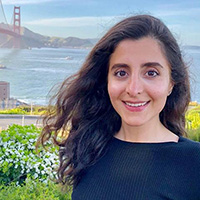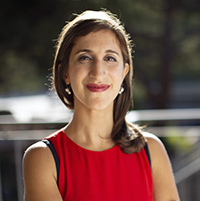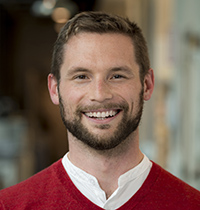UC San Diego Researchers Earn Air Force Young Investigator Awards
Published Date
Article Content
Three researchers at the University of California San Diego have been selected to receive Young Investigator Research Program awards from the Air Force Office of Scientific Research, the basic research arm of the Air Force Research Lab. The engineering and chemistry faculty will use the grant funding to study the way neurons in the brain communicate; aid our fundamental understanding of gas and plasma flow to accelerate the development of next-generation power and propulsion systems; and construct gas-responsive polymers for industrial applications.
The 2023 Young Investigator Research Program (YIP) recipients from UC San Diego are Assistant Professor of Nanoengineering Zeinab Jahed, Assistant Professor of Mechanical and Aerospace Engineering Lisa Poulikakos, and Assistant Professor of Chemistry and Biochemistry Nathan Romero.
YIP recipients must have received a PhD in the last seven years and show exceptional ability for conducting basic research with relevance to the Department of the Air Force. Awardees receive three-year grants of up to $450,000.
“With $120 million last year, UC San Diego receives more funding from the Department of Defense than any other University of California campus to pursue vital collaborative research projects,” stated Vice Chancellor for Research Corinne Peek-Asa. “These young investigator recipients are working on next-generation neurotechnology, power generation and new materials design, which will help support the Air Force’s efforts as a leader in air and space technology. Congratulations to Zeinab, Lisa and Nathan.”
“Through the YIP, the Department of the Air Force fosters creative basic research in science and engineering, enhances early career development of outstanding young investigators and increases opportunities for the young investigators to engage in forwarding the DAF mission and related challenges in science and engineering,” said Ellen Robinson, YIP program manager.
Learn more about the recipients and their YIP projects below:

Zeinab Jahed designs electronics that integrate intelligently with biological systems at the nanoscale. Through her YIP grant, she will use nanoelectrode recordings and neural networks to study the way neurons in the brain communicate through electrical pulses resulting from changes in their membrane potentials. This information encoded in the membrane potential waveforms is essential to understanding connectivity among neurons, and the underlying principles behind learning and memory, which could help treat neurological disorders.
To do this, Jahed will use nano-meter scale electrodes that her lab has developed, to measure thousands of waveforms from inside and outside of single neurons. She will use this data to fully reconstruct high resolution potential waveforms of hippocampal neurons, merely from low resolution measurements by machine learning techniques.
“Based on promising preliminary data, we anticipate that our proposed method could reliably reconstruct high-resolution neuronal potential waveforms providing a new direction for in-vitro and in-vivo neuronal recording for neuroscientists,” said Jahed.

Lisa Poulikakos uses nanophotonics, the study and manipulation of light at the nanoscale, to develop next-generation imaging platforms for a range of societally relevant challenges. Her YIP project will put forward a new class of miniaturized, on-chip nanostructured surfaces, known as “metasurfaces,” to quantitatively and non-intrusively visualize gases and plasma at unprecedented spatial resolutions. The findings promise to aid our fundamental understanding of gas and plasma flow, while circumventing the need for costly and complex optical components, which could potentially accelerate the development and deployment of novel power and propulsion systems.
For gas flow visualization, her proposed work will develop optical metasurfaces, which pattern light at resolutions smaller than the optical wavelength using a phenomenon known as “wavefront shaping”. For plasma flow visualization, her research will leverage the photoacoustic effect, where sound waves are controllably generated through laser-induced thermal expansion, on a nanostructured metallic film. This will enable the generation of patterned acoustic waves for non-intrusive plasma flow visualization at high spatial resolutions up to the optical diffraction limit.
“The AFOSR YIP program provides my lab with the incredible opportunity to pursue this highly interdisciplinary work,” said Poulikakos. “The proposed metasurface platforms will explore new avenues in nanoscale optics for super-resolution imaging while merging the physics of light and sound. I am truly excited to develop these metasurface technologies toward impactful applications in gas and plasma flow visualization.”

Nathan Romero's research project will create new materials capable of binding and releasing gas molecules. Many living organisms use gas molecules as signals to control various cell properties and functions, but it is difficult to create synthetic materials that have similar gas-responsive behaviors. Romero’s lab has discovered a way to construct polymeric materials that can bind and release gases like ethylene, carbon dioxide, and hydrogen. Ultimately, the results of this research could be used to design better protective equipment or to make industrial gas separation processes more energy efficient.
“This is the first external grant I’ve received in my independent career, so it will have a huge impact in jumpstarting the research program in my lab. The project funded by the AFOSR YIP award is particularly high risk-high reward, so I’m thrilled that we have the opportunity to explore an exciting class of new materials through the support of this grant.”
Share This:
Stay in the Know
Keep up with all the latest from UC San Diego. Subscribe to the newsletter today.




